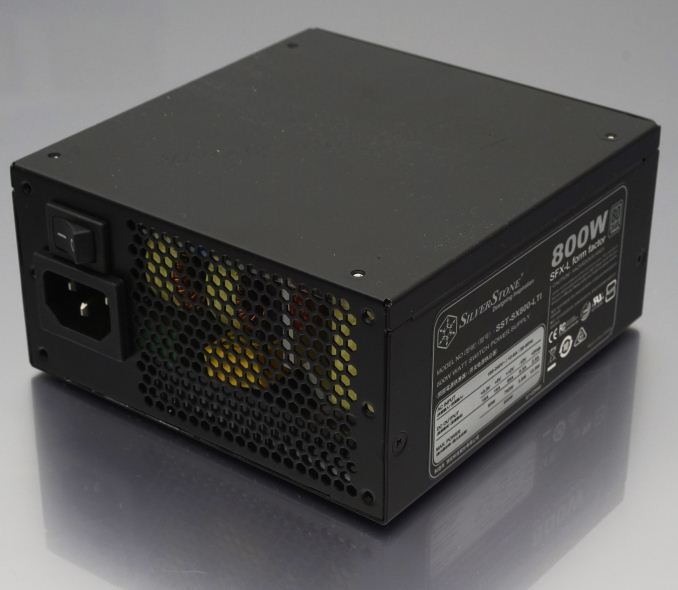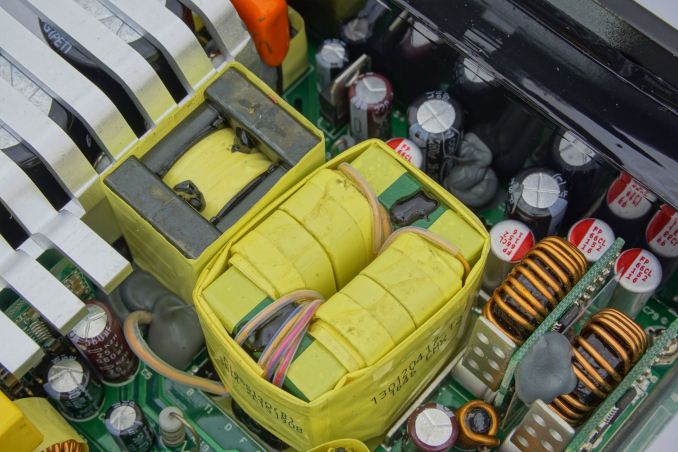The SilverStone SX800-LTI SFX-L 800W PSU Review: Big PSU, Small Niche
by E. Fylladitakis on January 18, 2018 9:00 AM EST- Posted in
- Cases/Cooling/PSUs
- SilverStone
- SFX
- SFX-L
Conclusion
ATX PSUs were the focus of R&D for decades while, at the same time, SFX designs were hardly available at all. This led to a massive performance gap between ATX and SFX units, as the latter started appealing to home users and gamers just a few years ago. Only a couple of years ago, the power quality of SFX units still was rather poor. The SilverStone SX700-LPT and, later on, the Enermax Revolution SFX 650W were the first SFX units that gave us performance figures on par with high-performance ATX units.
SilverStone is a company strongly focused on the R&D of small form factor cases (SFF), systems, and other related parts. They have several compact cases and products designed for high-end living room systems, including designs that were designed with gamers in mind. Therefore, their efforts to market the very best SFX PSUs available are not unfounded.
The SX800-LTI not only brings a record-high power output for an SFX-L design, but also is even further improved, with exceptional energy conversion efficiency and better power output quality than its predecessors. Note that the power quality is still not on par with that of top-tier ATX PSUs and it definitely is much louder than any equally powerful ATX design, but it would unquestionably be unfair to compare the SX800-LTI to any ATX unit. As far as SFX/SFX-L designs go, the SX800-LTI has the best overall performance that we have encountered to this date.
The extra length of the SX800-LTI makes it incompatible with most SFX-compliant cases. According to their compatibility charts, even most of SilverStone’s own cases are incompatible with this PSU. Its short wires make it incompatible with ATX-compliant cases as well, plus there really is no reason to purchase such an expensive SFX-L unit if one is planning to use an ATX-compliant case, as ATX PSUs are significantly less expensive and there is a much wider selection available. That the SX800-LTI is fully modular and there are adapters/cable sets available to allow its installation in an ATX case is a boon, but only for those that, for any given reason, may have to switch from their SFX-based system to an ATX-based system in the future.
The only real problem with this unit is that it lacks purpose. The SX800-LTI has only one CPU/EPS 8-pin connector, meaning that it cannot be used to power top-tier motherboards that have two 8-pin connectors, which is reasonable considering that current designs of such motherboards are all but impossible to fit inside SFX-compliant cases anyway. That leaves only the GPU(s) as the major load of the system. The power output and class of the SX800-LTI suggest that it needs at least two GPUs to even reach efficient loading levels. The only configuration that could bring the PSU’s loading up to 50-55% is that of SilverStone’s only compatible case, the RVZ02/ML08, with an NVIDIA TITAN V or AMD VEGA 64 installed. When moving to Micro-ATX motherboards with two PCIe ×16 slots, such as the Asus ROG Strix Z270G, cases that are roomy enough to house two full-size graphics cards also support ATX PSUs, so the SX800-LTI is an unappealing option. Only a SFX-compliant case designed for high-end Micro ATX motherboards is the natural habitat of the SX800-LTI, and there just are not many (if any) available at this time.












25 Comments
View All Comments
WithoutWeakness - Thursday, January 18, 2018 - link
Now that we have multiple options for medium-to-high output SFX power supplies I would like to see more case manufacturers design cases that drop ATX support and only support SFX PSUs. It's been amazing to see the designs that smaller case makers and newcomers have made when designing for the smallest cases possible and SFX PSUs have enabled them to dedicate less space for bulky ATX PSUs.DanNeely - Thursday, January 18, 2018 - link
On larger cases saving an inch on the PSU is a much smaller return than it is on mITX systems. Between the higher prices and much lower availability of SFX/SFXL PSUs I don't think we'll ever see widespread adoption of them in mATX/ATX cases.jtd871 - Thursday, January 18, 2018 - link
WithoutWeakness wasn't talking about larger cases. He was talking about cases without support for ATX PSUs.cjb110 - Friday, January 19, 2018 - link
Not sure they can do that and still call it an ATX case, which then makes marketing a potential nightmare, that might be one reason.Valantar - Monday, January 22, 2018 - link
There are a couple from Lian Li, and the Kimera Industries Cerberus is nice (if you can get it), but yeah, the selection is limited. I'd love to see more SFX+mATX or SFX+ATX cases. Why not?jrs77 - Thursday, January 18, 2018 - link
I've got the 500W SFX-L PSU from Silverstone and it's the sweetspot for a single GPU-system imho.meacupla - Thursday, January 18, 2018 - link
At this wattage, it's more like "We crammed in 800W, because we could".Even if you assembled the most powerful mITX system, using an Asrock X299E-ITX, an i9-79xx and 1080Ti and overclocked those, you would still be inside of 600W power envelope at full load.
(Going off of Coolermaster's power calculator)
edzieba - Thursday, January 18, 2018 - link
Don't forget SFF cases for mATX and ATX. While 800W is not enough for the quad Titan-V beast (smallformfactor DOT net/forum/threads/kimera-industries-cerberus-the-18l-matx-usa-made-enclosure.454/page-180#post-78461), you you drop back to a mere two Titan Vs - either on an mATX board or with ITX and PCIe Bifurcation - you can cram serious compute into an even smaller case.jordanclock - Thursday, January 18, 2018 - link
Because conversion efficiency is best at about 50% load, so you use a PSU like this to stay within the most efficient load range.Holliday75 - Thursday, January 18, 2018 - link
How much does that translate in savings on my electric bill? How quickly would that offset the cost of a higher wattage PSU running more efficiently?